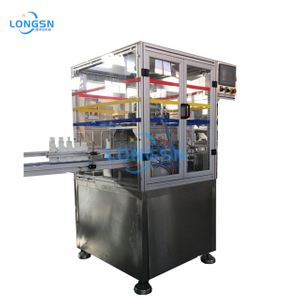In today’s fast-paced world, food packaging plays a vital role in preserving freshness, ensuring safety, and enhancing convenience. Among the various packaging solutions, plastic bottles, especially those made from PET (polyethylene terephthalate), are widely used for beverages, sauces, cooking oils, and dairy products. However, the production of high-quality plastic bottles for food applications involves strict hygiene, precision, and material requirements. One specialized piece of equipment that significantly improves the manufacturing and quality control of these bottles is the bottle neck cutting machine.
This detailed article explores the key advantages of using bottle neck cutting machines in the food packaging industry, offering a clear, easy-to-understand explanation of how this equipment contributes to efficiency, safety, and sustainability.
What Is a Bottle Neck Cutting Machine?
A bottle neck cutting machine is a precision tool designed to cut or trim the neck portion of plastic bottles. The neck refers to the upper part of the bottle where the cap or closure fits, including the threaded area. This part of the bottle must be perfectly shaped to ensure a secure seal and proper fit for caps or dispensers. Any irregularity in the neck can lead to leaks, contamination, or product loss.
Bottle neck cutting machines are typically used in:
Bottle manufacturing facilities
Food and beverage bottling lines
Plastic recycling and regeneration plants
Quality control departments
These machines are often integrated into automated production lines and controlled by programmable systems for accurate, high-speed operation.
The Role of Bottle Neck Cutting in Food Packaging
In food packaging, precision and hygiene are non-negotiable. Bottles must meet strict quality standards to ensure product safety and consumer satisfaction. The neck of the bottle, being the entry and exit point of the contents, plays a critical role in maintaining freshness and preventing contamination. Any deformity, rough edge, or misaligned thread can compromise the entire packaging process.
This is where bottle neck cutting machines come in. They help eliminate imperfections and standardize the shape of the bottle neck, offering several critical benefits in food-grade applications.
1. Enhanced Seal Integrity
A strong and airtight seal is essential for food packaging. The cap must fit perfectly onto the bottle neck to prevent leakage, spoilage, and contamination. However, during the blow molding process (which is used to make plastic bottles), the neck area can sometimes come out slightly uneven or too thick.
Bottle neck cutting machines trim the neck with high precision, ensuring that it conforms to exact dimensions. This guarantees that the cap will sit flush with the neck, forming a tight and leak-proof seal.
Benefits:
Prevents air, bacteria, or moisture from entering the bottle
Extends shelf life of perishable liquids like juice or milk
Eliminates product waste caused by leaking or loose caps
2. Consistent Bottle Dimensions for Automation
Modern food packaging lines are highly automated. Bottles are filled, capped, labeled, and packed using synchronized machines. If the bottles vary in neck height or shape, it can lead to jams, spills, or machine errors.
Bottle neck cutting machines ensure uniform neck size and shape, making the bottles compatible with capping and labeling machines. This consistency keeps the production line running smoothly and minimizes downtime due to misaligned bottles.
Benefits:
Improves overall line efficiency
Reduces machine wear and tear
Minimizes errors during filling and sealing
3. Improved Aesthetics and Brand Image
In the food industry, packaging design and appearance are crucial for brand identity and consumer appeal. A bottle with a clean, smooth neck looks more professional and attractive on store shelves. Irregular or rough-edged necks can make the product appear low quality or improperly manufactured.
Using a bottle neck cutting machine gives every bottle a clean finish, with precisely trimmed edges that enhance the product’s overall presentation. This subtle improvement can significantly impact the consumer’s perception of quality.
Benefits:
4. Reduction of Material Waste
During bottle production, excess plastic can accumulate around the neck area, especially if the mold is not perfectly aligned or maintained. If this material is not removed, it can interfere with capping and sealing, causing bottling issues or product recalls.
Bottle neck cutting machines remove this excess flash material efficiently, minimizing waste during the capping process. In addition, trimmed-off plastic from the neck can be recycled and reused within the production system, reducing overall material waste.
Benefits:
5. Higher Hygiene Standards
In food packaging, hygiene is a top priority. The neck area is where the product exits the bottle, making it a critical point for sanitation. Irregularities in the neck shape can create crevices or uneven surfaces that trap bacteria, dust, or other contaminants.
By ensuring a smooth and uniform neck cut, the machine helps create easier-to-clean surfaces and reduces the risk of harboring microbes. This is particularly important in dairy, baby food, and ready-to-drink product packaging.
Benefits:
6. Compatibility with Various Cap Types
Food and beverage products come with a variety of closures — screw caps, flip-tops, sports caps, tamper-evident seals, and more. Each of these closure types requires a specific neck profile to function correctly.
Bottle neck cutting machines allow manufacturers to customize the neck height and diameter, ensuring compatibility with a wide range of closures. This flexibility is important for product innovation and differentiation in competitive markets.
Benefits:
Supports diverse product lines
Enables unique packaging solutions
Reduces mismatch or defective packaging
7. Increased Production Speed
Manually inspecting and trimming bottle necks is not only time-consuming but also prone to human error. Bottle neck cutting machines operate at high speeds — processing hundreds to thousands of bottles per hour — while maintaining consistent quality.
By integrating these machines into the packaging line, manufacturers can significantly increase production output without compromising accuracy or hygiene.
Benefits:
8. Support for Recycling and Sustainability
In some food packaging lines, especially those involved in bottle-to-bottle recycling, removing the neck area is essential. The neck is often made from a different plastic than the bottle body, and cutting it off improves the quality of the recycled material.
This practice is common in circular production systems where bottles are collected, cleaned, and reused in manufacturing. Bottle neck cutting machines support this by separating incompatible materials early in the process.
Benefits:
Enhances recycling quality
Supports sustainable packaging goals
Contributes to circular economy practices
Real-World Example: Application in a Juice Bottling Plant
Imagine a juice bottling facility that produces 10,000 PET bottles per hour. If just 1% of those bottles have a neck defect that affects capping, that results in 100 compromised products every hour. This can lead to:
By installing a bottle neck cutting machine right after the blow molding stage, this plant ensures that all bottles have identical neck dimensions, greatly reducing the chance of leaks or faulty seals. Over time, the plant saves on labor, prevents waste, and ensures a more professional product on store shelves.
Features to Look for in a Bottle Neck Cutting Machine
For food packaging applications, it’s important to choose a machine with:
High precision rotary cutters for clean cuts
Adjustable height settings to fit different bottle sizes
High-speed processing (800–1100 bottles/hour or more)
Stainless steel construction for hygiene and corrosion resistance
Touchscreen and PLC control for easy operation
Safety features like emergency stops and blade enclosures
Leading manufacturers such as Zhangjiagang Longsn Machine Co., Ltd. provide bottle neck cutting machines that meet international food safety and production standards, making them a reliable choice for food and beverage packaging lines.
Conclusion
In the highly competitive and quality-conscious food packaging industry, every detail matters — including the shape and precision of a bottle’s neck. A bottle neck cutting machine offers a simple yet powerful solution to many of the challenges associated with bottle production for food-grade applications.
By ensuring a clean, consistent neck profile, these machines contribute to better sealing, improved hygiene, smoother automation, reduced waste, and enhanced product presentation. They also help manufacturers stay compliant with strict food safety regulations while boosting productivity and sustainability.
In short, bottle neck cutting machines are not just tools — they are valuable allies in producing safe, reliable, and attractive food packaging. As consumer expectations and industry standards continue to rise, adopting such precision equipment is no longer a luxury but a necessity for forward-thinking food manufacturers.

 English
English









